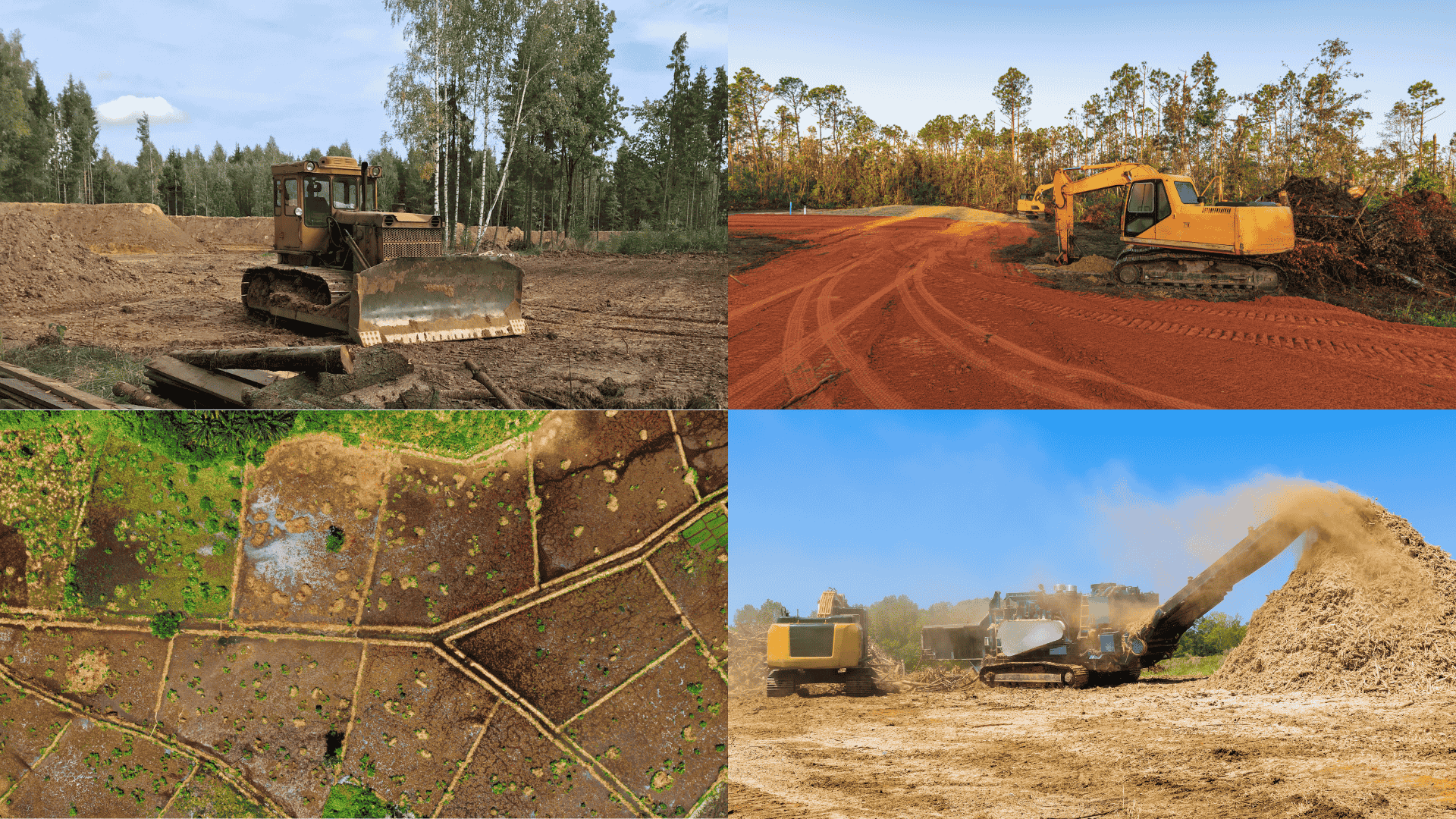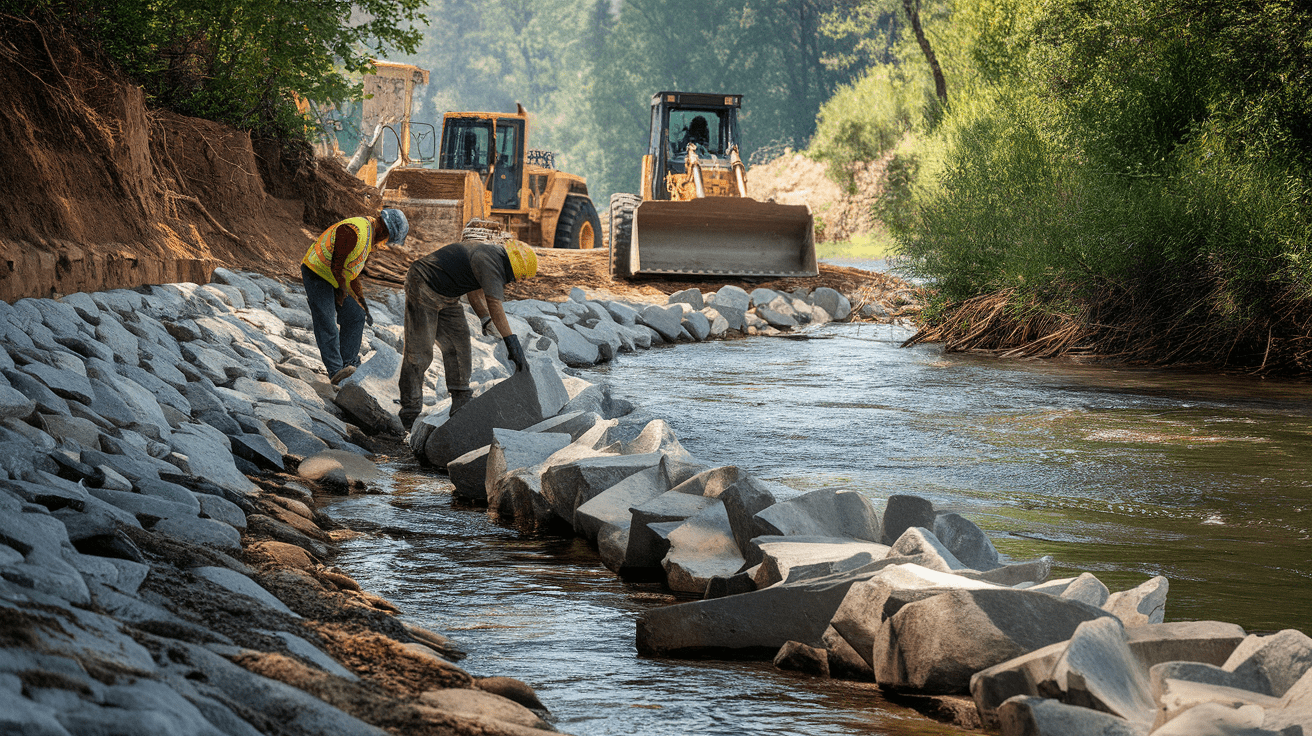Land clearing plays a vital role in preparing properties for various development projects, including residential construction, commercial buildings, and agricultural use.
For anyone planning to build a home, start a farm, or develop commercial property, understanding land clearing is essential.
This detailed resource will help property owners understand different land clearing services and find the right providers who specialize in this essential work.
From costs and methods to selecting contractors, we cover everything you need to make informed decisions.
What is Land Clearing?
Land clearing is the process of removing trees, brush, rocks, and other obstacles from a piece of property to prepare it for its intended use.
This service is essential for construction projects, farming operations, and landscaping improvements.
Land clearing serves multiple purposes, including construction preparation, agricultural development, commercial projects, safety improvements, and fire prevention.
Types of Land Clearing Methods
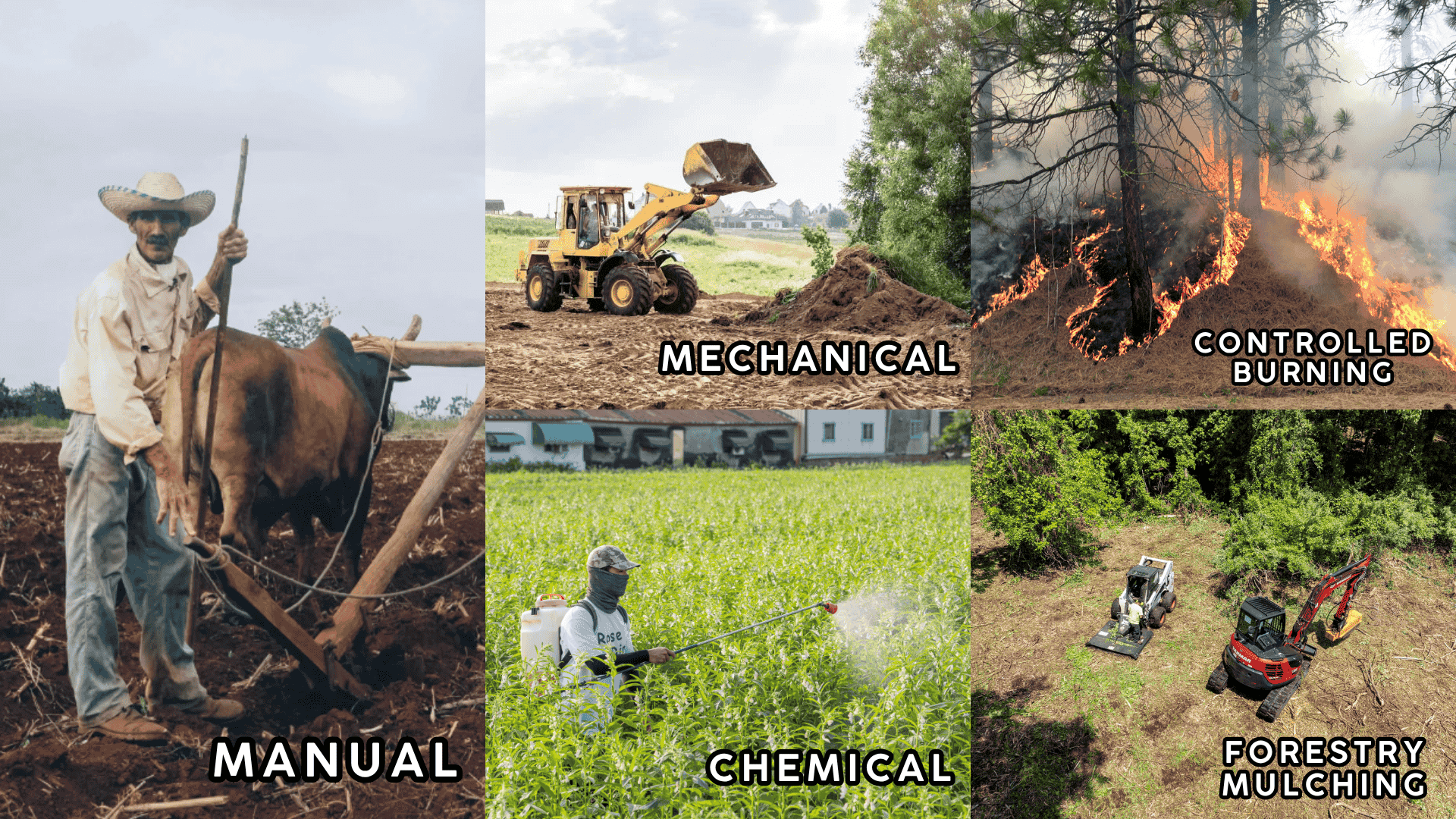
Professional land clearing companies use three main approaches:
1. Manual Clearing
Workers use hand tools like chainsaws, axes, and machetes to remove vegetation.
This method works best for smaller areas or when precision is required around existing structures.
Manual clearing also allows for selective removal while protecting nearby plants and landscaping.
2. Mechanical Clearing
Heavy machinery such as bulldozers, excavators, and mulchers removes large amounts of vegetation quickly.
This approach is ideal for bigger projects and dense forest areas.
Mechanical methods are the most cost-effective option for clearing large properties efficiently.
3. Chemical Clearing
Herbicides and other chemicals help control unwanted vegetation growth.
This method is often combined with other techniques for long-term vegetation management.
Chemical clearing is particularly effective for preventing regrowth after initial mechanical or manual clearing.
4. Controlled Burning
Also known as prescribed burning, this method uses fire to clear brush, small trees, and undergrowth in a controlled manner.
Fire crews carefully manage the burn area, timing, and conditions to safely remove vegetation.
This technique is commonly used in forestry and agricultural land management, particularly in regions prone to wildfires.
5. Forestry Mulching
Specialized mulching machines grind trees, brush, and vegetation into mulch in a single pass, leaving the mulched material on the ground.
This method eliminates the need for debris removal and hauling, as the mulch naturally decomposes and enriches the soil.
Forestry mulching is environmentally friendly and works well for properties with moderate vegetation density.
Land Clearing Process
I’d like to give credit to: FLTchannel for their informative video, which served as a reference for this guide.
The typical land clearing process helps property owners know what to expect and prepare accordingly.
Professional companies follow established steps to ensure safe, efficient, and compliant project completion.
1. Site Inspection and Planning
Professional land clearing begins with a thorough site inspection.
Technicians evaluate the property to identify:
- Types and density of vegetation
- Soil conditions and drainage patterns
- Slope and terrain challenges
- Environmental considerations
- Access points for equipment
Based on this assessment, they develop a detailed clearing plan that outlines methods, timeline, and safety measures.
2. Timeline Estimates
Project duration depends on several factors:
- Small residential lots (under 1 acre): 1-3 days
- Medium properties (1-5 acres): 3-7 days
- Large commercial sites (5+ acres): 1-3 weeks
- Dense forest clearing: 2-4 weeks per acre
Complex terrain, weather conditions, and permit requirements may extend these timeframes.
Tools and Equipment for Land Clearing
Modern land clearing requires specialized machinery and tools to handle projects efficiently and safely.
Professional contractors use a combination of heavy equipment and hand tools depending on the project scope and terrain conditions.
Heavy Machinery
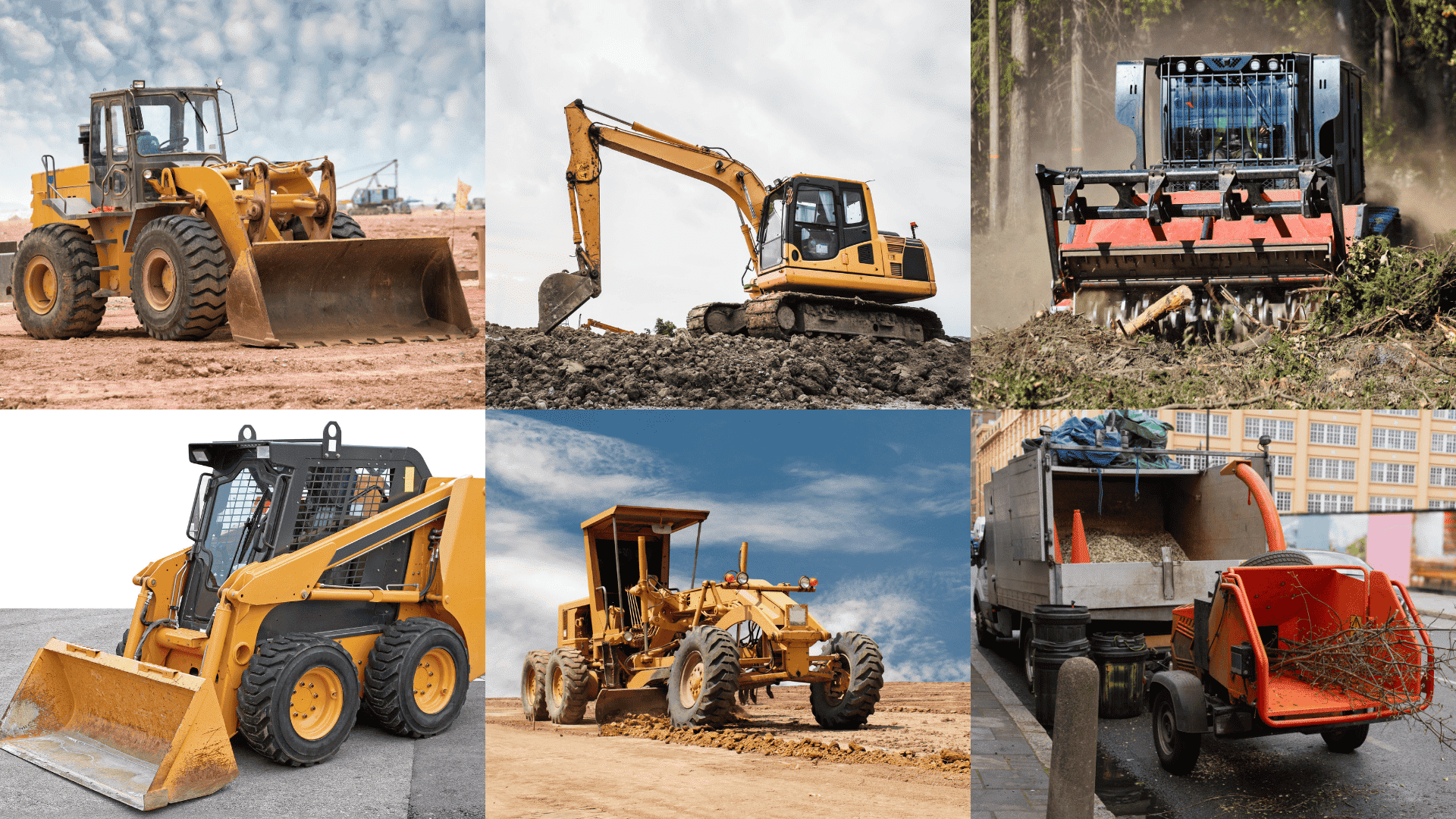
Heavy machinery forms the backbone of large-scale land clearing operations, providing the power needed to remove substantial vegetation and move earth efficiently.
- Bulldozers: Push over trees and move large amounts of material across the site. These powerful machines are essential for clearing dense vegetation and grading rough terrain.
- Excavators: Dig out stumps and handle precise removal tasks with their hydraulic arms and attachments. They’re versatile machines that can also move debris and load trucks.
- Mulchers: Grind vegetation into small pieces for easy disposal or on-site decomposition. Forestry mulchers can process entire trees in a single pass, creating mulch that enriches the soil.
- Skid Steers: Work in tight spaces and handle lighter clearing tasks with various attachments. Their compact size makes them ideal for residential projects and areas with limited access.
- Graders: Level and smooth the ground surface after clearing, creating proper drainage slopes, and preparing the site for construction.
- Wood Chippers: Process branches and smaller trees into wood chips for disposal or landscaping use.
Hand Tools
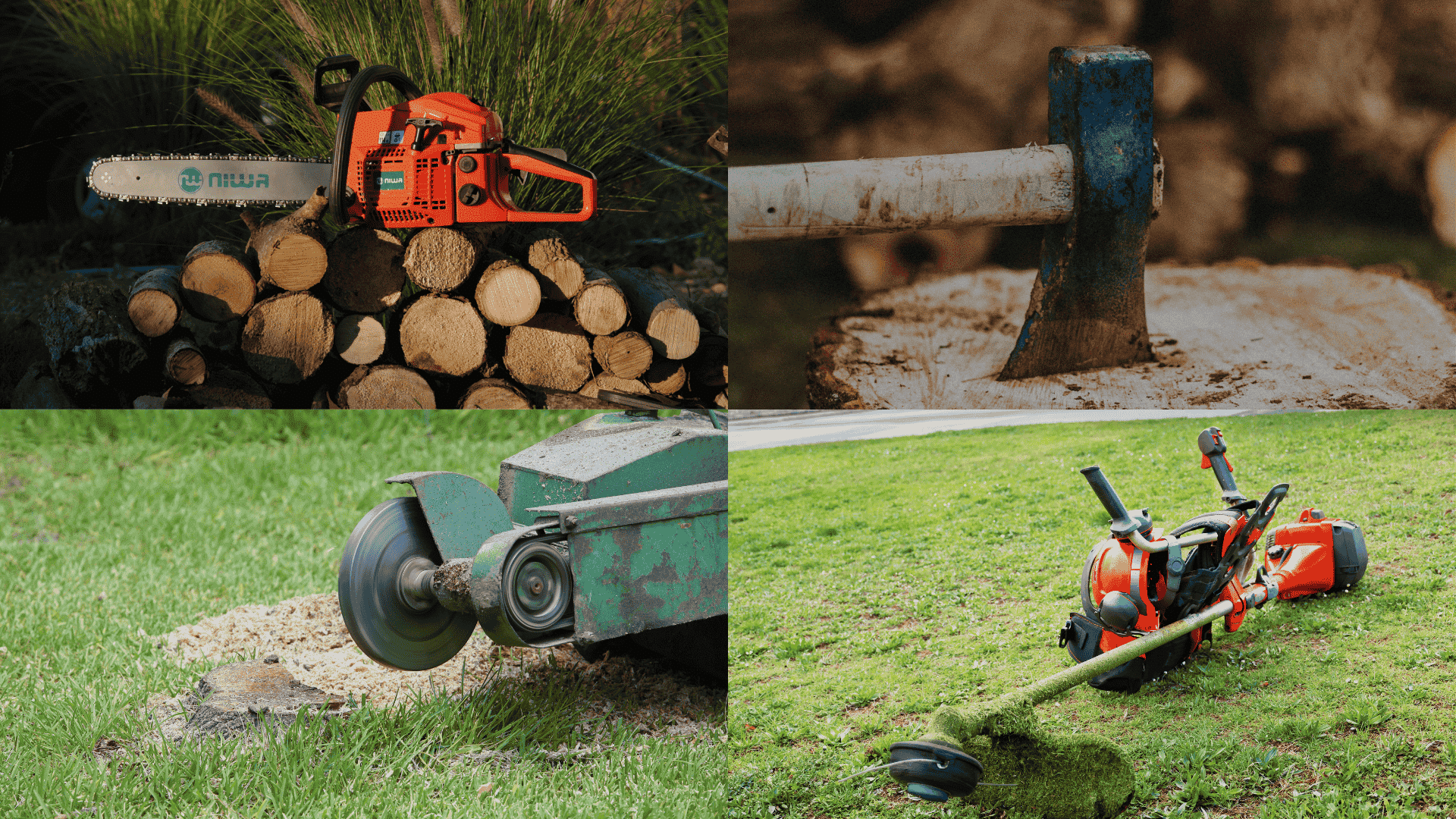
Hand tools provide precision and control for smaller clearing tasks, detailed work, and areas where heavy machinery cannot safely operate.
- Chainsaws: Cut through trees and branches with precision, essential for selective clearing and detailed work around structures.
- Axes and Machetes: Remove smaller vegetation, vines, and brush in areas where machinery cannot reach.
- Stump Grinders: Remove tree stumps below ground level, eliminating tripping hazards and preparing the site for planting or construction.
- Brush Cutters: Clear dense undergrowth and tall grass more efficiently than manual cutting.
Pro Tip: Always verify that your contractor’s crew uses proper safety gear (hard hats, protective eyewear, chainsaw chaps, gloves, steel-toed boots) and holds required equipment operator licenses to ensure safe, compliant operations.
Land Clearing and Leveling
Land clearing and leveling are often performed together as complementary services to prepare properties for construction and development.
Learning the differences and benefits of each helps property owners plan their site preparation effectively.
Land Clearing
Land clearing is the initial step in transforming raw property into a usable space, focusing on removing all obstacles that stand in the way of development.
Purpose: To prepare a construction or farming site by removing any elements that would obstruct the intended use of the land.
Process: Involves using heavy machinery to uproot and remove trees, brush, stumps, rocks, debris, and old structures from the property.
Benefits:
- Creates a safe and secure site for construction.
- Improves land aesthetics and visibility.
- Helps with pest removal and fire hazard reduction.
- Prepares land for its intended use.
Land Leveling
Land leveling follows clearing and focuses on creating the ideal surface conditions for construction, farming, or landscaping projects.
Purpose: To create a stable, flat, or uniformly sloped surface for better drainage, efficient resource distribution, and stable foundations.
Process: Soil is moved from higher areas to lower areas using heavy machinery like scrapers, graders, or tractors to achieve a smooth, even surface. Modern methods often use laser-guided technology for greater precision.
Benefits:
- Ensures uniform irrigation and better crop yields.
- Provides stable foundations and prevents structural problems.
- Prevents water pooling and protects structures from damage.
The following table highlights the key differences between land clearing and leveling to help you understand each service:
| Aspect | Land Clearing | Land Leveling |
|---|---|---|
| Primary Goal | Remove vegetation and obstacles | Create an even, stable surface |
| Key Equipment | Bulldozers, excavators, mulchers | Graders, scrapers, laser-guided tractors |
| What’s Removed/Changed | Trees, stumps, rocks, debris, structures | Soil elevation and surface irregularities |
| Typical Timeline | 1-3 weeks, depending on density | 3-7 days depending on area size |
| When It’s Done | First step in site preparation | After clearing is complete |
| Cost Range | $500-$8,000+ per acre | $1,500-$5,000 per acre |
| Best For | Overgrown or forested properties | Properties with uneven terrain |
| Result | Clear, obstacle-free land | Smooth, graded surface ready for use |
Common Land Clearing Services
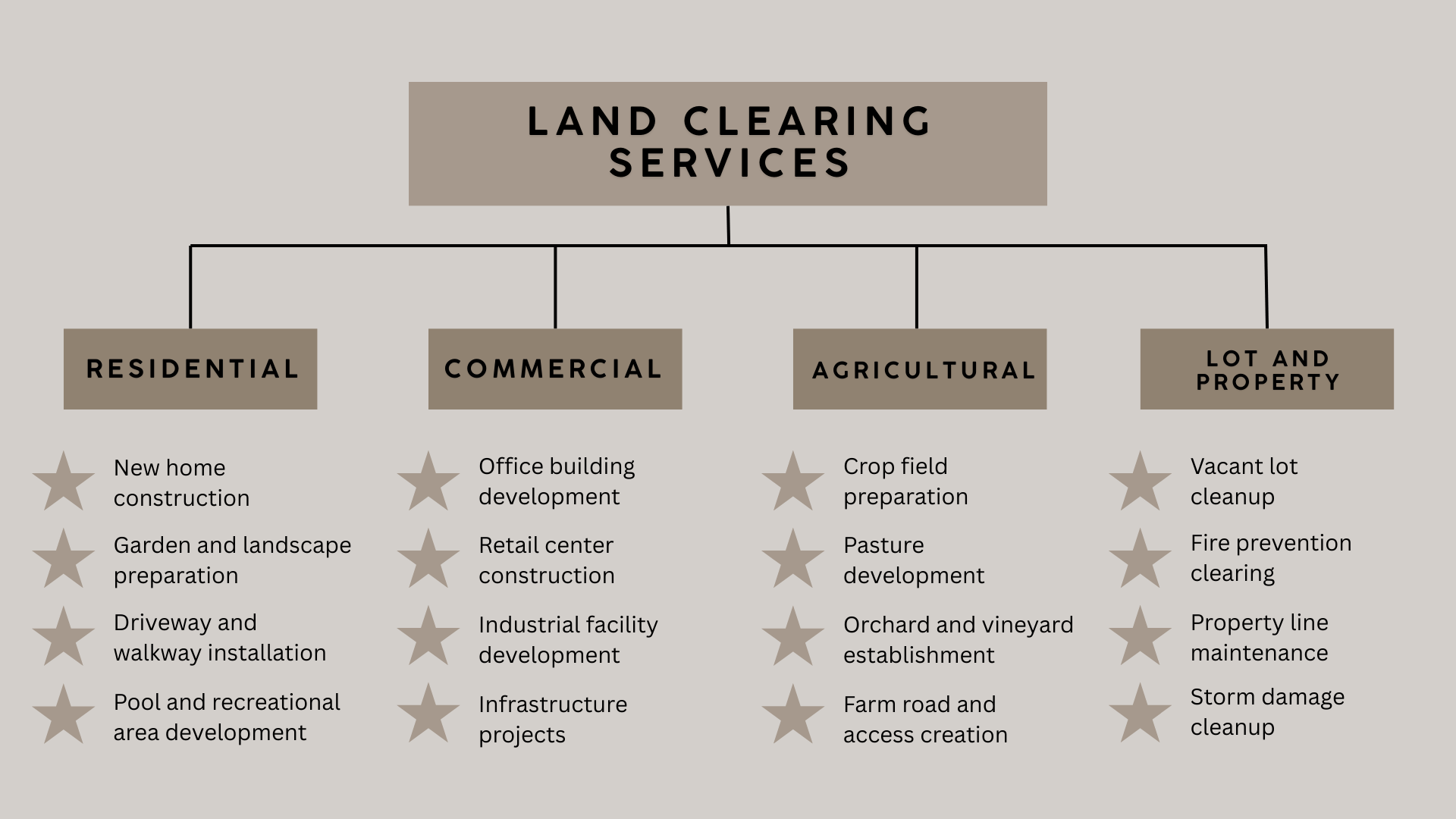
Land clearing companies provide specialized services tailored to various property types and project objectives.
Understanding these service categories helps you identify the right contractor for your specific needs.
Each service type requires different equipment, expertise, and approaches to meet the unique requirements of residential homeowners, commercial developers, agricultural operators, and property maintenance needs.
Benefits of Hiring a Professional Land Clearing Service
While some property owners consider handling land clearing themselves, working with professional services offers significant advantages.
From safety considerations to regulatory compliance, professionals bring valuable expertise that saves time and money while ensuring quality results.
- Expertise and Experience:Professional companies have specialized knowledge of safe clearing methods. DIY attempts can be dangerous and costly.
- Efficiency and Speed:Professionals complete projects in days with proper equipment, while DIY efforts take weeks.
- Compliance with Regulations:Professional companies handle permits and ensure regulatory compliance.
How to Choose the Right Land Clearing Service?
With many companies offering similar services, knowing what to look for helps you make an informed decision and avoid costly mistakes.
When selecting a land clearing service provider, evaluate these important aspects:
- Experience: Look for companies with years of experience in similar projects. Ask for past work examples and client references.
- Equipment: Ensure the company has modern, well-maintained equipment suitable for your project size and terrain.
- Certifications and Insurance: Verify proper licenses, certifications, and comprehensive insurance coverage for your protection.
- Local Knowledge: Choose providers familiar with your state and local area’s regulations, soil conditions, and environmental requirements.
List of Businesses Specializing in Land Clearing
When searching for land clearing services, consider these different types of specialized companies:
1. Local Excavation and Earthwork Companies
These contractors specialize in earthmoving and construction site preparation with heavy machinery.
Their services include:
|
Large-scale clearing projects using bulldozers and excavators, Combined clearing and grading services, Complete site preparation for construction projects, Foundation and utility preparation. |
2. Tree Service and Forestry Specialists
Companies focused on professional tree care and forest management services.
They offer:
|
Safe removal of large and challenging trees, Tree trimming and pruning services, Work near power lines and buildings, Selective tree preservation and careful vegetation management. |
3. Site Preparation Contractors
Professionals who specialize in preparing land specifically for construction projects.
Key services include:
|
Knowledge of building codes and drainage requirements, Soil condition assessment and preparation, Comprehensive services from clearing through final grading, Coordination with architects and builders. |
4. Agricultural Land Management Firms
Specialists who work with farmers and ranchers on land development for farming operations.
They provide:
|
Land clearing for crops, pastures, and farming operations, Soil preservation and agricultural drainage solutions, Farm road and equipment access creation, Ongoing land management and maintenance services. |
5. Environmental Restoration Companies
Companies that combine land clearing with environmental protection and restoration.
Services offered:
|
Projects in environmentally sensitive areas, Environmental permit assistance and compliance, Erosion control and soil protection measures, Wetland protection and habitat preservation services. |
Land Clearing Costs
Land clearing costs help you budget effectively and avoid unexpected expenses.
Multiple factors influence pricing, and knowing what affects costs allows you to make informed decisions about your project scope and contractor selection.
Factors Influencing Cost
Several variables affect land clearing pricing:
- Property Size: Larger areas generally cost less per acre due to economies of scale, but total project costs increase.
- Vegetation Density: Heavily wooded areas with large trees cost more to clear than properties with light brush and small trees.
- Terrain Difficulty: Steep slopes, rocky soil, and poor access increase labor time and equipment requirements.
- Equipment Needed: Projects requiring specialized machinery or multiple machine types cost more.
- Disposal Requirements: Areas with limited debris disposal options may incur additional hauling and dumping fees.
Typical Cost Ranges
The following table provides typical land clearing cost ranges, with pricing varying based on vegetation density and regional location:
| Clearing Type | Cost per Acre | Description |
|---|---|---|
| Light clearing | $500-$2,000 | Minimal vegetation, small trees, brush |
| Moderate clearing | $2,000-$4,000 | Medium-density trees and vegetation |
| Heavy clearing | $4,000-$8,000 | Dense forest, large mature trees |
| Extreme clearing | $8,000+ | Very dense forest, difficult terrain |
Costs tend to be higher in states like California, New York, and Massachusetts, while lower in states like Texas, Alabama, and Georgia.
Additional Services:
- Stump grinding: $100-$400 per stump
- Grading: $1-$3 per square foot
- Debris hauling: $300-$800 per load
Conclusion
Land clearing services convert raw land into usable space for construction, farming, and development.
Choosing the right contractor and method ensures your project stays on budget and meets all safety standards.
Professional companies provide the expertise, equipment, and regulatory knowledge necessary for safe and efficient project completion.
Investing in quality land clearing sets the foundation for successful long-term property development.
Ready to start your land clearing project?
Share your project plans or questions in the comments below, and let us know what type of land clearing service you’re considering.
Frequently Asked Questions
What’s the Best Time of Year for Land Clearing?
Late fall through early spring is typically ideal when trees are dormant and ground conditions are more stable. However, timing depends on your local climate and project deadlines.
What Happens to the Cleared Debris and Wood?
Most contractors offer several options, including hauling debris away, chipping it into mulch for your use, or burning it on-site with proper permits. Some valuable timber may be sold to offset project costs.
Can I Keep Some Trees While Clearing the Rest of the Property?
Yes, selective clearing allows you to preserve mature trees, specimen plants, or trees that provide privacy and shade. Discuss your preferences during the planning phase.

